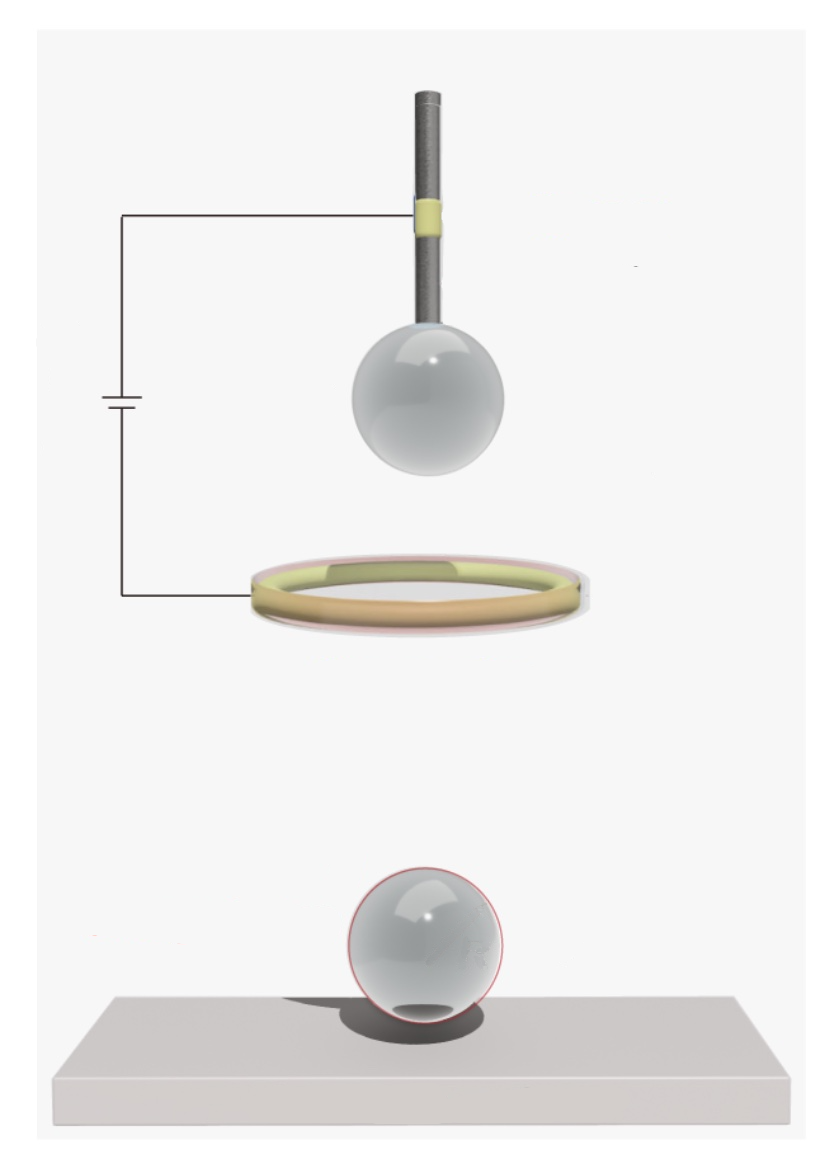Charged Droplets Can Hit a Surface Without Splashing
Liquid droplets hit solid surfaces in a range of technological processes, such as spray coating and inkjet printing. Typically, the collision causes the droplet to break up into many tiny fragments, creating a splash. A research team has now shown that electrical charging of droplets can reduce or even entirely suppress the splashing, offering greater control over the impact process [1]. The findings could be useful in the design of more precise and efficient droplet-related technologies.
Electrical charging of droplets is very common both in nature and in technology, for example, in thundercloud electrification. The charging usually results from contact electrification, where friction, or even mere contact, between two surfaces results in electrons or ions passing between them. The effect can be exploited technologically: For example, mechanical engineer Zuankai Wang, now at the Hong Kong Polytechnic University, and his colleagues have previously shown that the charge on falling water droplets can be harnessed for electricity generation [2].
Wang and his colleagues wondered whether droplet charging might also be used to control the dynamics of impact with a surface. Typically, as a droplet falls onto a horizontal surface, a thin sheet, or “lamella,” of the liquid is ejected all around the circumference of the impact zone. This sheet spontaneously breaks up into tiny beads that are thrown outward to create a rather messy splash [3].
The process that creates a lamella involves the transfer of momentum from the vertical direction of the falling drop to the horizontal direction of the surface. The radial sheet of liquid may be lifted away from the surface because of both lubrication by a gas film that can form under the lamella and a suction force that results from the different pressure on its upper and lower faces. This liftoff leads to lamella breakup and causes splashing.
To systematically examine how this process is affected by the charge on the droplet, Wang and his colleagues devised an apparatus for controlling the droplet charge. They allowed ethanol to drip from a syringe needle, typically making drops 0.8 mm across. By creating an electric field between the needle tip and a horizontally oriented copper ring positioned just below it, the researchers could alter the charge on a drop: The stronger the field, the greater the charge.
They recorded video of the lamellae that formed when the droplets hit a glass surface 20–60 cm below the needle. According to their data, charge within a lamella can alter its shape and trajectory. “Surface charges on the lamella tend to be attracted to regions of higher dielectric constant, namely, the surface,” says Wang. In addition to pulling the liquid sheet downward, the attraction also makes it contract. So for a charged droplet, the lamella lifts less from the surface and is also smaller in extent—both factors reduce the tendency for the lamella to fragment into tiny droplets.
Above a critical threshold of droplet charge, there is no lamella liftoff at all: The impacting drop merely spreads laterally over the surface. When the researchers replaced the glass surface with one of indium tin oxide, an electrical conductor, there was no such suppression, because the charge on each droplet was rapidly conducted away on impact. The researchers accurately predicted the outcomes using a simple fluid-dynamical model that incorporated the forces acting on the fluid.
Wang says that being able to suppress splashing this way could be very useful in various technologies. “In inkjet printing, it could significantly enhance print quality and enable higher resolution,” he says. “And in spray-coating processes, minimizing splashing ensures uniform coverage, reduces material waste, and lowers the environmental impact.”
Fluid dynamicist José Gordillo of the University of Seville in Spain, who has worked previously on droplet impacts, says that the results represent “a major step forward in the scientific description and precise quantification” of the effect of charge on droplet splashing. The experiments are challenging to conduct and have been “performed with extreme care,” he says, and he is impressed by the match between theoretical predictions and experimental results. Gordillo also agrees with Wang that the findings should have useful applications for industrial processes.
–Philip Ball
Philip Ball is a freelance science writer in London. His latest book is How Life Works (Picador, 2024).
References
- F. Yu et al., “Why charged drops do not splash,” Phys. Rev. Lett. 134, 134001 (2025).
- W. Xu et al., “A droplet-based electricity generator with high instantaneous power density,” Nature 578, 392 (2020).
- G. Riboux and J. M. Gordillo, “Experiments of drops impacting a smooth solid surface: A model of the critical impact speed for drop splashing,” Phys. Rev. Lett. 113, 024507 (2014).





